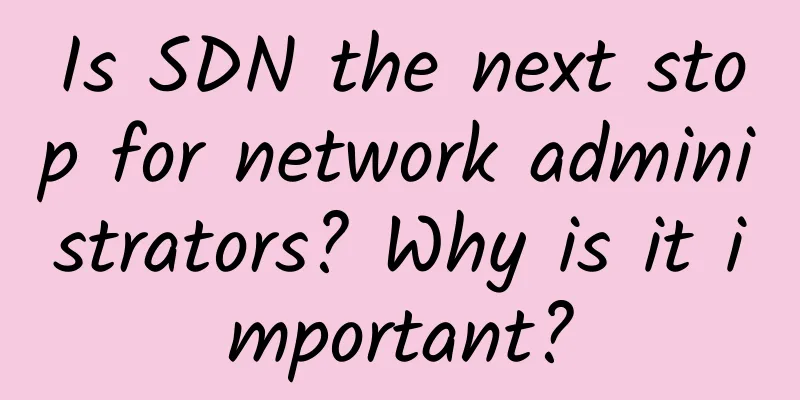Is SDN the next stop for network administrators? Why is it important?

|
SDN (Software Defined Networking) has become one of the most common ways for enterprises to deploy applications. The technology helps enterprises deploy applications at a faster pace and reduce overall deployment costs. SDN enables administrators to manage and configure network services from a centralized location. The benefit of this setup is that more enterprises than ever are starting to ask "What is SDN" and migrate. One of the reasons for SDN's growing prominence is the problems inherent in transforming traditional networks. Over the past few years, the demands of modern businesses have grown exponentially, and physical infrastructure has struggled to keep up. It is in this environment that virtualization solutions such as SDN have begun to grow and prosper. Market research predicts that the SDN market will reach $3.52 billion in 2018. It’s no secret that manually configured hardware has not kept up with the advancement of modern technology. Traditional networks simply can’t keep up with the demands of modern enterprise users. SDN offers a welcome alternative for enterprises, who can upgrade their network infrastructure with minimal disruption. Today we’re starting to see companies deploy SDN solutions like Cisco Open SDN Controller, Beacon, Brocade SDN Controller, and Juniper Networks’ Contrail, to name a few. In this article, we break down what SDN is and look at the pros and cons of leveraging this technology in an enterprise environment. What is SDN? As mentioned above, SDN stands for Software Defined Networking. SDN is a networking approach that uses open protocols such as OpenFlow to control software at the edge of the network. It is used to control access to switches and routers. It is almost impossible to find a collective definition of SDN because its architecture can vary from enterprise to enterprise.
However, the basic purpose of SDN is to allow users to virtualize their hardware. Software defined networking attempts to build computer networks by dividing them into two parts. The control plane can provide performance and fault management of NetFlow, IPFIX and SNMP protocols. This plane is often used to remotely manage the configuration of devices connected to the SDN. The second is the data plane, which is responsible for forwarding traffic to its final destination. The control plane dictates which path the flow will take before reaching the data plane. This is done by using flow protocols. The data plane is where administrators interact with the SDN and actually manage the network. Initially, SDN was deployed by large organizations such as Google and Amazon to produce scalable data centers. SDN can facilitate the expansion of network resources and new servers while minimizing the management burden. In other words, SDN makes the upgrade process more efficient. Since SDN's early adoption, other large companies have been keen to implement the technology to be able to upgrade more efficiently. 2. How is SDN different from traditional networks? The biggest difference between traditional networks and SDN is that the latter is a software-based network. Traditional networks rely on physical infrastructure such as switches and routers to establish connections and function properly. In contrast, software-based networks allow users to control resource allocation at a virtual level through a control plane. Instead of interacting with physical infrastructure, users interact with software to provision new devices. From this perspective, administrators can determine network paths and proactively configure network services. SDN also has the ability to communicate with more devices throughout the network than traditional switches. The core difference between the two can be summarized as virtualization. SDN virtualizes the entire network. Virtualization creates an abstract version of the physical network, allowing resources to be configured from a centralized location. In traditional networking, the data plane tells your data where it needs to go. Similarly, under the traditional networking model, the control plane is located within a switch or router. The location of the control plane is particularly inconvenient because administrators cannot easily access and direct traffic (especially when compared to SDN). Under SDN, the control plane becomes software-based and accessible through connected devices. This means that administrators can control traffic from a centralized user interface with greater scrutiny. This gives users greater control over how their network functions. It is also possible to change the configuration settings of the network from the comfort of centralized management. Managing configurations in this way is particularly beneficial for segmentation of the network, as users can juggle many configurations quickly. The reason SDN is an alternative is that it allows administrators to provision resources and bandwidth on the fly. It does this while eliminating the requirement to invest in more physical infrastructure. In contrast, if the network capacity of a traditional network is increased, new hardware is required. The traditional model is to buy more equipment. 3. SDN and SD-WAN It is not uncommon to hear SDN compared to software-defined wide area networks (SD-WAN). SD-WAN is a commonly used alternative solution that allows enterprises to link multiple locations together by using broadband and MPLS. The main difference between SDN and SD-WAN is that SD-WAN focuses on providing a wide area network (WAN) that connects multiple sites together. In contrast, SDN is used to create a network that can be quickly modified according to the needs of the enterprise. SDN is designed for use with local area networks (LANs), while SD-WAN is designed to maintain a WAN over a large geographic area. It is worth noting that SD-WAN can be used on an SDN network, providing the geographic capabilities of SD-WAN with the configurable flexibility of SDN. One of the reasons SD-WAN has become popular is that it eliminates the need to maintain a large amount of network hardware. Another particularly important difference between the two is that SDN is completely configured by the user or administrator. SD-WAN services are managed by the vendor. In practice, this means that SD-WAN is easier to deploy in terms of management because the user is not responsible for providing the service. You can remove routing hardware in favor of cloud services. Operating with cloud services means that if your needs increase, it can be upgraded very quickly (especially compared to traditional networks where you have to physically update the infrastructure). SD-WAN also has the advantage of supporting services such as VPNs. Many enterprises are using SD-WAN as a way to support their VPNs. Advantages of SDN
1. Centralized management One of the main benefits of SDN is the ability to manage the network from a centralized perspective. In short, SDN virtualizes the data and control planes, allowing users to configure physical and virtual elements from a single location. This is extremely useful because traditional infrastructure can be difficult to monitor, especially if there are many different systems that need to be managed individually. SDN removes this barrier. 2. Scalability One good thing about centralized configuration is that SDN provides users with more scalability. With the ability to configure resources at will, the network infrastructure can be changed at any time. Compared to traditional network setups that require manual purchase and configuration of resources, the difference in scalability is very obvious. 3. Security Although the growth of virtualization has made it more difficult for administrators to protect their networks from external threats, it has brought huge advantages. SDN controllers provide administrators with a centralized location to control the entire security of the network. Although this comes at the expense of making the SDN controller a target, it provides users with a clear view of the infrastructure through which they can manage the security of the entire network. 4. Reduce hardware footprint By deploying SDN, administrators can optimize hardware usage and improve work efficiency. Users can assign active hardware with new purposes at will. This means that resources can be shared relatively easily. This exceeds traditionally driven networks where hardware is limited to one purpose. Disadvantages of SDN
1. Delay One of the issues with virtualizing any infrastructure is the resulting latency. The speed at which you interact with a device depends on the amount of virtualized resources available. Your service is determined by how the hypervisor divides up your usage (potentially increasing latency). Every active device on the network degrades network availability. This will only intensify in the future as more Internet of Things (IoT) devices enter the market and begin to integrate into the fabric. 2. Limited Management Even if you can manage device services across your entire network, you can’t manage the devices themselves. While this may seem like a trivial detail at first glance, it is very important for scaling your network. All of these devices require frequent monitoring, patching, and upgrades to keep them working. Therefore, it’s important to remember the extensive maintenance requirements that SDN does not address. 3. More complex network management While traditional networks may have their limitations, there is a standardized consensus on security threats and procedures. Currently, no such consensus has been reached for SDN. While there are many SDN solution providers, SDN security issues are uncharted territory for many administrators. Therefore, maintaining the integrity of SDN services against external threats can be very difficult when you don’t have the necessary knowledge to protect the system. After all, the ability to prevent attacks depends on detecting threats before they occur. To do this requires a level of expertise in SDN that is difficult to achieve without extensive experience using SDN systems. While someone without experience can learn to use SDN, they will need to go through a substantial learning curve in order to manage the nuances of security threats. 6. Deployment Best Practices While SDN does offer many advantages, its deployment is not hassle-free. To ensure that SDN operates effectively, there are many steps that need to be taken when deploying this solution. SDN deployment can be more complex than other network resources, so it is important to understand some of the factors you need to consider. 1. Cancel configuration One of the biggest benefits that SDN offers is the ability to quickly deploy new resources. However, this capability needs to be managed closely to maintain performance. In practice, this means regularly decommissioning resources when they are not needed. Keeping resources active when not in use takes up virtual resources that are better used elsewhere. 2. Network monitoring Every professional administrator recognizes the importance of network monitoring, but surprisingly, there are relatively few products that are compatible with SDN. This is problematic because an SDN needs to be monitored to ensure it is secure and performing satisfactorily. In order to monitor an SDN, you need APIs so that the SDN can integrate with them. 3. Security When adding any new technology, there are new security risks to consider. SDN is no exception. From the moment you deploy SDN, you expose new vulnerabilities to the network that can be maliciously attacked. Therefore, you need to fully understand the current security threats and how to address them. This includes a thorough understanding of protocol limitations, especially handoff simulation. It also means that you must implement new best practices to protect your services from external threats. 4. Maintaining service quality Quality of Service (QoS) monitoring is a nightmare in any network, but SDN networks require special attention. As we discussed earlier, with SDN, you can control services, but not physical devices. Therefore, resources need to be configured with special care. In addition, the default Quality of Service settings on each network device also need to be kept in mind, as they can have a large impact on the quality of network performance. 7. SDN and Network Monitoring As mentioned earlier in this article, SDN presents many challenges when it comes to network monitoring. Many people give a lot of thought to the advantages and disadvantages that SDN brings in terms of performance, but rarely consider how it changes the network monitoring process. The main challenge is that you can’t monitor SDN the same way you can a traditional network using traditional network monitoring solutions. SDN monitoring is difficult because it is a dynamic service. As such, services can be provisioned and deprovisioned quickly. This means you need a network monitoring tool that can keep up with these changes; a tool like SevOne can be a good starting point for monitoring SDN, but you may need to go a step further and use the API to submit a program. The best way to respond to the rapid changes of SDN is to use a performance monitoring solution with an API. This will track resources as you configure them. A network monitoring platform with an API will be able to keep up with the demand and ensure that your network environment is not lost or obscured. Products with APIs give you more flexibility than other static network monitoring solutions. Another core feature you need in an SDN monitoring solution is the ability to add additional monitoring capacity. Whenever you upgrade your network infrastructure with SDN, you need a monitoring solution that can scale to keep track of that. If your network monitoring solution doesn’t have the bandwidth to monitor your SDN, that’s no good. 8. Achieving Transformation Before switching to SDN, it will require spending a significant amount of money on new equipment. While this will result in long-term savings in physical hardware and scalability, it is certainly worth considering before making a purchase. Before you consider scrapping all of your traditional infrastructure, it’s best to run on a hybrid network! Selectively adding SDN equipment to your setup allows you to stay familiar with your traditional network infrastructure while minimizing disruption to your services. 9. SDN: The Next Generation of Networks? Given the popularity of virtualization, it can be expected that the number of enterprises deploying SDN will increase significantly. As networks become more complex, with cloud services and disparate infrastructure, systems such as SDN will be used to help large organizations achieve centralized control and scalability. Traditional networks simply do not have an adequate foundation to meet the needs of modern enterprises. While it is important to realize that SDN cannot fully manage the physical burden of devices throughout the network, it still helps to centrally control the network's services themselves. Managing the network infrastructure through a control plane provides administrators with a higher level of control than traditional traditional networks. Although there are quite a few SDNs, they are still in their infancy. It can be said that this technology does have great potential to grow beyond the obstacles brought by traditional networks. Enterprises are always looking for ways to reduce the complexity of network management and reduce general management costs. The value of SDN in this regard is very promising. SDN still has a long way to go. While it has a great foundation, it will need to evolve if it is to achieve widespread adoption. At this point, it is difficult to point to any clear metrics for the ROI that SDN provides. The centralizing benefits of SDN may be clear, but if traditional infrastructure is to be pushed aside, the ROI needs to be clearly defined. |
<<: Detailed explanation of the differences between IPv6 and IPv4!
Recommend
Blockchain makes cities smarter and more innovative
This article takes stock of the smart city applic...
U.S. tech firms push new software to disrupt my country's 5G lead
Top U.S. technology companies are pushing a softw...
Enrich online and in-app user experience and increase ROI through optimized video
Today's consumers are more eager than ever to...
Industrial IoT and manufacturing will become one of the largest 5G markets
Private 5G networks are attractive to the largest...
China Unicom will gradually withdraw 2G network users and allow them to change their cards for free
2G will become history, users can change cards fo...
Millimeter wave is imperative to unleash the full potential of 5G!
As my country's 5G network construction scale...
What is Intelligent Edge Computing?
You’ve heard of edge computing. You may have even...
Megalayer: 40% off on Hong Kong Alibaba/Huawei Cloud hybrid line servers, 50% off on high-defense servers, and 50% off on home broadband VPS
Megalayer has released its regular promotion for ...
Industrial Ethernet Market Expected to Exceed $350 Billion by 2032
The Industrial Ethernet market will grow from a c...
Σco Time | Huawei Cloud Smart Healthcare Solution builds an intelligent epidemic prevention and control system
[51CTO.com original article] Although the COVID-1...
RAKsmart: $59/month-2*E5-2620v2/32GB/1TB/50M bandwidth/South Korea server
Thanks to the advantage of physical distance, mos...
On the eve of large-scale commercial use of 5G, private LTE networks will take the lead in IoT applications
In the past few days, South Korea and the United ...
The ransomware incident is a microcosm of global cybersecurity
On May 12, more than 75,000 computer virus attack...
LOCVPS Hong Kong VPS is 30% off and starts from 25.9 yuan/month, with BGP optimized lines in Hong Kong Tsuen Wan/Tai Po/Yundi/MG and other data centers
LOCVPS has released a 30% discount code for all V...
Interesting, 5G base station and fire hydrant logo combined
Following the integration of 5G base stations wit...









